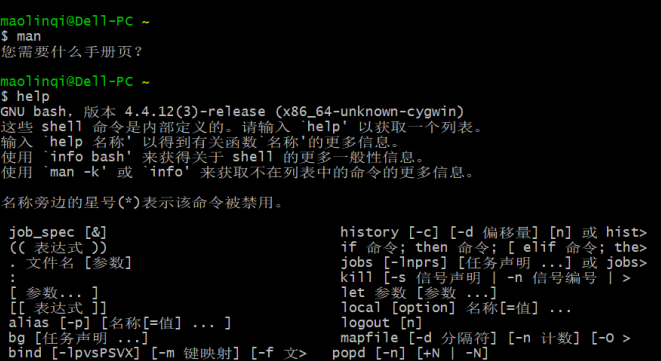OS第1次实验报告:熟悉使用Linux命令和剖析ps命令
- 毛琳淇
- 201821121007
- 计算1811
1. 实验环境介绍
- 操作系统:Windows10
- 平台:Cygwin
- 用户名:maolinqi

2. 常用命令使用

3. 剖析ps命令
(1)man ps
使用方法:
SYNOPSIS
ps [−aA] [−defl] [−g grouplist] [−G grouplist]
[−n namelist] [−o format]... [−p proclist] [−t termlist]
[−u userlist] [−U userlist]
参数:
The following options shall be supported:
−a Write information for all processes associated with termi‐
nals. Implementations may omit session leaders from this
list.
−A Write information for all processes.
−d Write information for all processes, except session leaders.
−e Write information for all processes. (Equivalent to −A.)
−f Generate a full listing. (See the STDOUT section for the
contents of a full listing.)
−g grouplist
Write information for processes whose session leaders are
given in grouplist. The application shall ensure that the
grouplist is a single argument in the form of a <blank> or
<comma>-separated list.
−G grouplist
Write information for processes whose real group ID numbers
are given in grouplist. The application shall ensure that
the grouplist is a single argument in the form of a <blank>
or <comma>-separated list.
−l Generate a long listing. (See STDOUT for the contents of a
long listing.)
−n namelist
Specify the name of an alternative system namelist file in
place of the default. The name of the default file and the
format of a namelist file are unspecified.
−o format Write information according to the format specification given
in format. This is fully described in the STDOUT section.
Multiple −o options can be specified; the format specifica‐
tion shall be interpreted as the <space>-separated concate‐
nation of all the format option-arguments.
−p proclist
Write information for processes whose process ID numbers are
given in proclist. The application shall ensure that the
proclist is a single argument in the form of a <blank> or
<comma>-separated list.
−t termlist
Write information for processes associated with terminals
given in termlist. The application shall ensure that the
termlist is a single argument in the form of a <blank> or
<comma>-separated list. Terminal identifiers shall be given
in an implementation-defined format. On XSI-conformant sys‐
tems, they shall be given in one of two forms: the device's
filename (for example, tty04) or, if the device's filename
starts with tty, just the identifier following the characters
tty (for example, "04").
−u userlist
Write information for processes whose user ID numbers or lo‐
gin names are given in userlist. The application shall en‐
sure that the userlist is a single argument in the form of a
<blank> or <comma>-separated list. In the listing, the nu‐
merical user ID shall be written unless the −f option is used,in which case the login name shall be written.
−U userlist
Write information for processes whose real user ID numbers or
login names are given in userlist. The application shall
ensure that the userlist is a single argument in the form of
a <blank> or <comma>-separated list.
(2)ps -ef
返回结果:
UID PID PPID TTY STIME COMMAND
maolinqi 329 1 ? 18:31:43 /usr/bin/mintty
maolinqi 339 330 pty0 18:32:48 /usr/bin/ps
maolinqi 330 329 pty0 18:31:44 /usr/bin/bash
参数的含义:
e:显示所有进程。
f:显示用户ID、父进程ID、最近CPU使用情况和进程时间等等。
每个字段的含义:
UID:用户ID
PID:进程ID
PPID:父进程ID
C:进程占用CPU的百分比
STIME:进程启动到现在的时间
TTY:终端的次要装置号码
TIME:CPU运行时间
CMD:命令的名字
(3)ps -aux
执行结果:
PID PPID PGID WINPID TTY UID STIME COMMAND
1070 1069 1070 7528 pty0 197609 19:02:16 /usr/bin/bash
1082 1070 1082 11408 pty0 197609 19:05:16 /usr/bin/ps
1069 1 1069 17928 ? 197609 19:02:11 /usr/bin/mintty
参数含义:
a:显示终端机下的所有程序,包括其他用户的程序
u:以用户为主的格式显示程序状况
x:显示所有程序
字段含义:
COMMAND:命令的名字
4. 通过该实验产生新的疑问及解答
(1)修改用户名时找不到etc/passwd文件
解:使用mkpasswd -l > /etc/passwd把windows的用户导入到cygwin下。根据搜索到的博客改用户名。
(2)执行命令ps -aux时出现ps: user x unknown
解:百度发现"ps -aux"打印用户名为"x"的用户的所有进程,以及打印所有将由-a选项选择的过程。如果用户名为"x"不存在,ps的将会解释为"ps aux",而且会打印一个警告,所以要使用ps aux。




